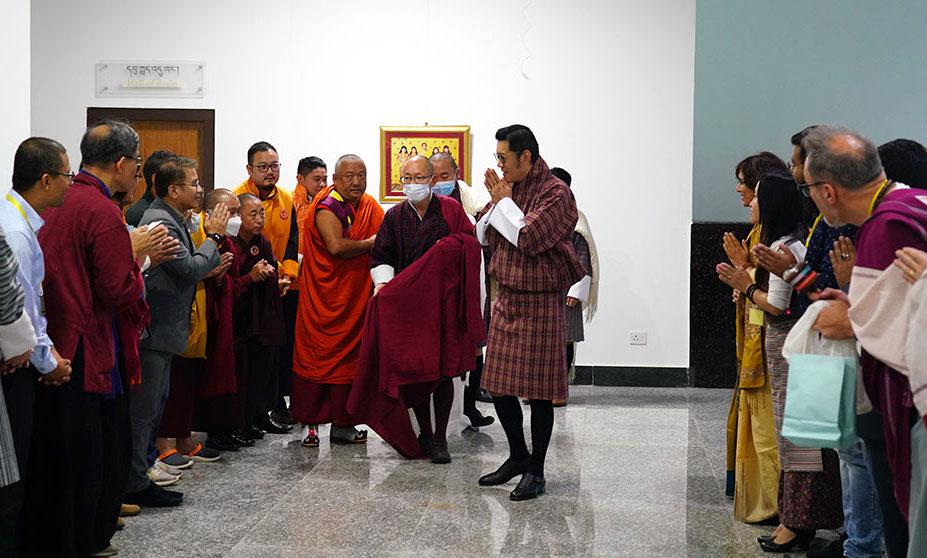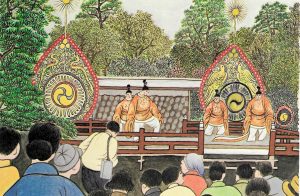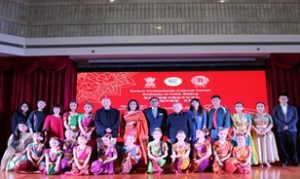The Himalayan Kingdom of Bhutan launched the fourth International Conference on Vajrayana Buddhism in the capital Thimphu earlier this month—the first time in three years that the conference has been possible due to travel restrictions during the pandemic. The four-day symposium was held under the theme “Modernity of Buddhism,” running from 1–4 October.
The forum brought together more than 300 dignitaries, guests, attendees, and speakers from Bhutan and 37 nations, including distinguished scholars and practitioners of Vajrayana Buddhism, alongside senior religious figures, to present, examine, and discuss the practices and traditions of Vajrayana Buddhism and the way they creatively adapt to life in the 21st century.
The four-day gathering addressed a wide array of topics that approached the core theme of the context of Vajrayana Buddhism in modern life, amid evolving social, environmental, economic, and technological circumstances around the world. Papers and presentations touched upon the contemporary interface with Buddhist philosophy; mindfulness, meditation, and Buddhist practice; politics and geopolitics; health and well-being; AI and digital technology; ecology and the environment; socially engaged Buddhism; yoginis, bhikkhunis, and female empowerment; and Buddhism and the arts.
The event was organized by the Zhung Dratshang, Bhutan’s Central Monastic Body, and the Centre for Bhutan studies & GNH (CBS), with support from International Buddhist Confederation, India.

Speaking on the significance of the conference, CBS president Dasho Karma Ura noted that Vajrayana Buddhism offers a unique perspective on human existence, and as such has an invaluable role as a source of inspiration and insight for human society and its endeavors.
“The Central Monastic Body, which is co-hosting the conference, is an embodiment of the Vajrayana institution, dedicated to combining skillful means in practice and wisdom in realizing that nothing exists inherently. Its many offerings can be globalized, and one way is again through events as this,” Dasho explained. “As to how the conference is germane to today’s issues, Buddhism offers its own distinctive bearings and viewpoints, and in that sense it is also a source of insights on how anyone might approach and shape economics, business, management, environment, food, trade, technology, ethics, social organization, politics, and so on, from a Buddhist framework of understanding our human condition and its future. Knowledge and outlooks are, truly speaking, quite plural, and we should be open to exploring which ones can shine a better light and show a better path ahead to a common future.”
CBS is tasked by the Bhutanese government with conducting and coordinating research and other activities related to Bhutan’s development concept of Gross National Happiness (GNH). Remote and landlocked, and perched in the rarified air of the eastern Himalaya, Bhutan is regularly ranked among the happiest countries in the world. With a population of just 763,249, according to the government’s projection for 2022, Bhutan is also one of the world’s smallest and least industrialized countries, yet it has significant experience in maintaining the delicate balance of managing economic growth in a sustainable manner, famously encapsulated in its conservative GNH approach to economic development.
The philosophy of GNH was introduced in the late 1970s by the country’s fourth king, Jigme Singye Wangchuk, informed by the kingdom’s traditional Buddhist culture. An alternative to traditional metrics for measuring national development, such as gross national product (GNP) or gross domestic product (GDP), GNH is founded on four underlying principles or “pillars” of good governance, sustainable socio-economic development, the preservation and promotion of traditional culture, and environmental conservation.
Presentations on the first day of the conference included examinations of research into mind-body practices in Vajrayana Buddhism, manifestations of Vajrayana in the West, values and ethics cultivated on the Vajrayana path, and Vajrayana in everyday life.
Among the highlights of the conference, His Eminence Kalu Rinpoche, lineage holder of the Shangpa Kagyu tradition of Tibetan Buddhism, gave a presentation on the once “secret” practice of Niguma Yoga. His Eminence observed that Niguma was one of two fully realized dakini mahasiddhas whose wisdom and teachings led to the formation of the Shangpa Kagyu lineage.
“The yoga exercises of the Niguma tradition are extremely beneficial for both the physical body and the inner subtle body, which is related to the cultivation and circulation of internal energy and vital essences,” said Kalu Rinpoche. He added: “Unlike Tummo, the auxiliary practices of Niguma Yoga can be taught openly without prerequisite empowerments.”
The conference also presented an exhibition titled “Buddhist Calligraphy: An Emerging Art” by the renowned calligrapher Jamyang Dorjee Chakishar, 71, of Sikkim, India, who is also a record holder for the world’s longest calligraphy scroll at 165 meters. Chakrishar noted that the practice of calligraphic art is a skillful means that can help the practitioner perceive the nature of the mind, the ultimate goal of all Buddhist teachings.

Bhutan, nestled in the foothills of the Himalayan mountain range, and sandwiched between the two political and economic heavy hitters India and China, is the world’s last remaining Vajrayana Buddhist country. The spiritual tradition is embedded in the very consciousness and culture of this remote land, where it has flourished with an unbroken history that dates back to its introduction by Padmasambhava, also known as Guru Rinpoche, in the eighth century. Almost 85 per cent of Bhutan’s population identify as Buddhists, with Hinduism accounting for the majority of the remainder. Most of Bhutan’s Buddhists follow either the Drukpa Kagyu or the Nyingma schools of Vajrayana Buddhism.
See more
Center for Bhutan & GNH Studies
Related news reports from BDG
142 Buddhist Nuns Receive Full Ordination at Landmark Ceremony in Bhutan
Buddhist Monks in Bhutan Join Movement to Raise Awareness of Sexual Health and Rights
Bhutan Tiger Center Set to Open New Conservation Center in August
Bhutan Nuns Foundation Announces Opening of the Training & Resource Center for Buddhist Nuns
India Presents Buddha Statue to Bhutan on the Birth Anniversary of Padmasambhava
Buddhist Kingdom of Bhutan Hosts Third International Vajrayana Conference
Related features from BDG
Gelongma Dompa (dgeslongma’i sdom pa): The Blessing of Bhikshuni Ordination in Bhutan
Sing Me A Song: The Impact of Screens on a Remote Bhutanese Mountain Village
Ten Years of Empowering Female Monastics: Bhutan Nuns Foundation Extends Reach with New Training Center
















